With thick rinds and unusual shapes, winter squashes — such as acorn, butternut and kabocha — can be a little intimidating, especially compared with their summer counterparts. Unlike thin-skinned zucchini, pattypan and straightneck varieties, which are so delicate they can be eaten raw, all winter squashes require cooking. Happily, they are quite simple to prepare. Roasted, steamed or sautéed, these hearty vegetables can be used in most any kind of dish. And feel free to enjoy them often: They support cardiovascular health, balance blood sugar and may even help ward off cancer.
So don’t let their hard shells put you off. Behind that tough facade lies a tender and comforting surprise.
Quick and Easy
Roasted: Cut squash in half, scoop out seeds, place on a sheet tray cut-side down, and roast at 450 degrees F for about 20 minutes. When squash has cooled enough to handle, turn it over and serve with a little olive oil or butter. Or scoop out the flesh, mash and use in your favorite recipes.
Stuffed: Cut open and scoop out the seeds. Roast the squash until just cooked, and then fill with a savory cooked stuffing of your choice — meat, whole-kernel grains and vegetables, for example. Roast together until stuffing is heated through.
Puréed: Use a blender or mixer to purée cooked squash, then use as a base or addition to soups, risottos, dips, sauces, baked goods, casseroles, even smoothies.
Cubed or sliced: After it is peeled and seeded, squash can be easily cut into small pieces, then roasted or steamed for use in your favorite vegetable medley. Prepared ahead of time and kept in the refrigerator, roasted cubes or slices of squash, served cool or warmed, make an excellent addition to salads and stir-fries. Try squash bits tossed with arugula or spinach, toasted pumpkin seeds, and dried cranberries.
Seeds: Roasted squash seeds make a satisfying, healthy snack. Wash and allow to dry completely, and then roast with a bit of ghee and curry powder.
Varieties of Winter Squash
- Acorn: Sweet, nutty and peppery, baked acorn squash is a classic.
- Butternut: Excellent steamed and in soups, the sweet, nutty butternut is a good squash for beginners.
- Delicata: The creamy delicata tastes like a cross between sweet potatoes and butternut squash and is wonderful sautéed.
- Hubbard: Less sweet than many varieties, hubbard squash has a grainy texture and is best baked and served mashed or puréed.
- Kabocha: With sweet flavors and dry, flaky flesh, kabocha — the Japanese word for squash — can be baked, steamed or sautéed.
- Pumpkin: The dark orange flesh of the pumpkin is excellent mashed and in pies. It will store in a cool, dark, dry place for two to three months.
- Spaghetti: A surprising and nutty stand-in for pasta, the flesh of this squash separates into spaghetti-like strands when cooked.
Nutritional Know-How
- All carbs are not created equal. Squashes may be starchy, but many of their carbohydrates come from polysaccharides, which have antioxidant, anti-inflammatory, anti-diabetic and insulin-regulating properties. Polysaccharides are also found in foods like mushrooms and sea vegetables.
- The antioxidant properties of winter squash are also boosted by carotenoids, vitamin C and manganese.
- The body converts winter squashes’ beta-carotene and carotenoid phytonutrients into immune-supporting vitamin A.
- Winter squashes are more nutrient-dense — particularly in beta-carotene and B vitamins — than their summer counterparts, which contain most of their nutrients in their rinds.
- Winter squashes contain omega-3 fatty acids and cucurbitacins with powerful anti-inflammatory properties.
- There are hundreds of squash varieties grown worldwide, and while their nutrients are quite similar, they do vary. The deeper the orange color of the flesh, for example, the more beta-carotene it contains.
Kitchen Tricks
- If you plan to bake winter squash, cut the ends off first so it’s easier to cut the squash in half lengthwise and remove the seeds. For rounder varieties, grasp the squash firmly and use a sharp knife to cut through to the center, then rotate the squash and cut until it falls open. Given a few fork pricks while baking, smaller varieties like gold nugget and sweet dumpling squash can be baked whole fairly quickly.
- After it is baked, winter squash can easily be peeled, then cut to desired size for your recipe. Alternately, cool the baked squash, then scrape or scoop the flesh out of the skin.
- When cut into 1-inch cubes, most squash needs only seven minutes to steam.
Shopping and Storage Tips
- Choose squashes that have hard, smooth, deep-colored rinds, are heavy for their size, and are free of moldy spots.
- Squash pulls both nutrients and chemical contaminants from the soil, so buy organic or responsibly farmed whenever possible.
- Known as “good keepers,” winter squashes can be stored between one week and six months, depending on variety. Store whole in a dry, dark, cool place, ideally around 50 to 60 degrees F, until ready for cooking.
- Before freezing, cook winter squash and cut to size for your recipes.
Recipes
Thai Squash Curry
This spicy meal is wonderful with any sturdy, meaty squash, such as kabocha or delicata.
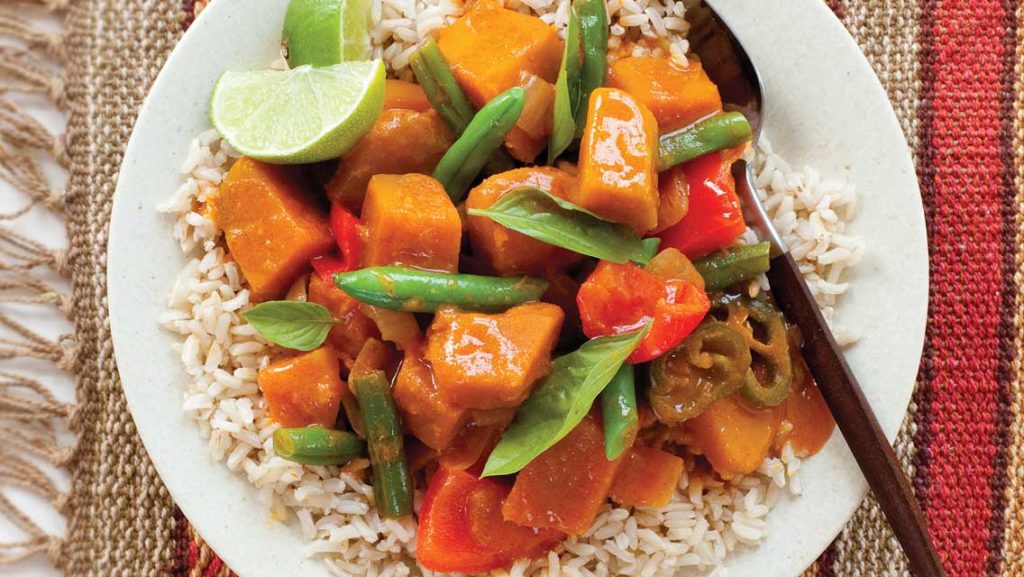
Makes | six servings
Ingredients
- 1 tbs. coconut oil
- 1/4 cup red curry paste
- 1 medium yellow onion, diced (about 11/2 cups)
- 1 red bell pepper, diced
- 1 medium kabocha or other firm-fleshed squash, cubed (about 4 cups or 1 pound)
- 2 cups green beans, cut into 1-inch pieces
- 1 to 2 jalapeños, sliced
- 1 1/4-ounce can coconut milk
- 8 ounces water
- 2 tsp. fish sauce
- 2 kaffir lime leaves, torn into small pieces
- 6 cups cooked brown rice
- 1/4 cup Thai basil leaves for serving
Directions
- Heat the coconut oil in a heavy Dutch oven and add curry paste. Stir to flavor the oil, then add the onions and peppers and cook for two to three minutes, stirring to coat with the curry paste.
- Add squash and jalapeños, and cook for about five minutes while stirring.
- Add the coconut milk, water, fish sauce and kaffir lime leaves, and cover and simmer until squash is just tender, about five to seven minutes.
- Serve over brown rice and top with fresh Thai basil.
Grilled Winter Squash Tacos
Using grilled winter squash instead of meat brings a tasty twist to this taco. Serve with a zesty quinoa salad.
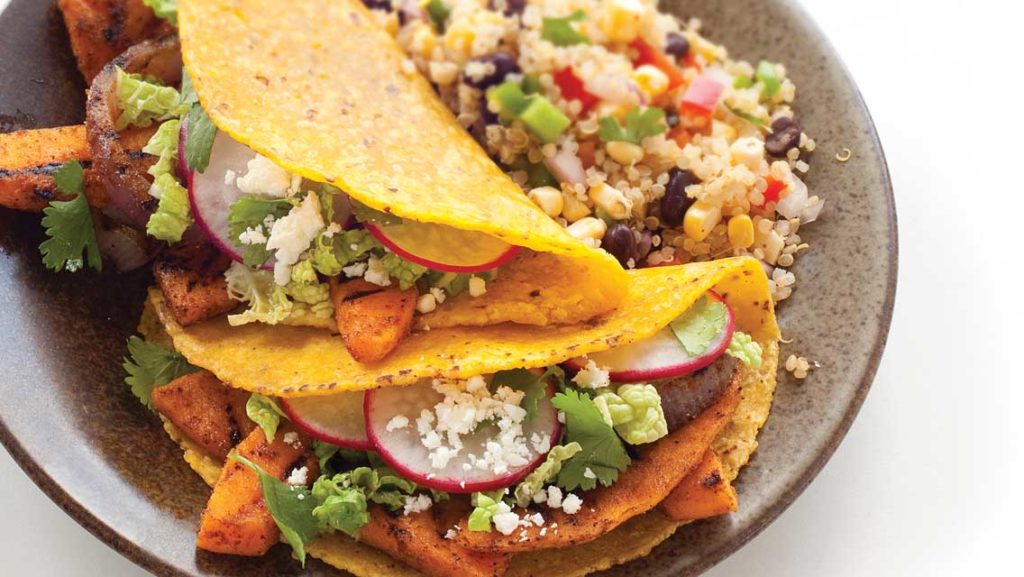
Makes | four servings
Ingredients
- 1 butternut squash, about 1 1/2 pounds, peeled, seeded and cut into 1/4-inch slices
- 4 thick slices red onion
- 1 tbs. olive oil
- 2 tsp. ground coriander
- 2 tsp. ground cumin
- 1/2 tsp. salt
- Cayenne pepper to taste
- 8 corn tortillas
- 6 radishes, thinly sliced
- 1/2 cup shredded napa cabbage
- 1/4 cup chopped fresh cilantro
- 1/2 cup crumbled Cotija cheese or feta cheese
Directions
- Heat a grill pan or grill. Toss the sliced squash and onion with the olive oil and spices, and cook until just tender.
- Serve in tortillas and add fresh toppings.
Baked Squash and Apples With Ginger and Pecans
A simple and elegant side dish that brings out the best and brightest in both main ingredients.
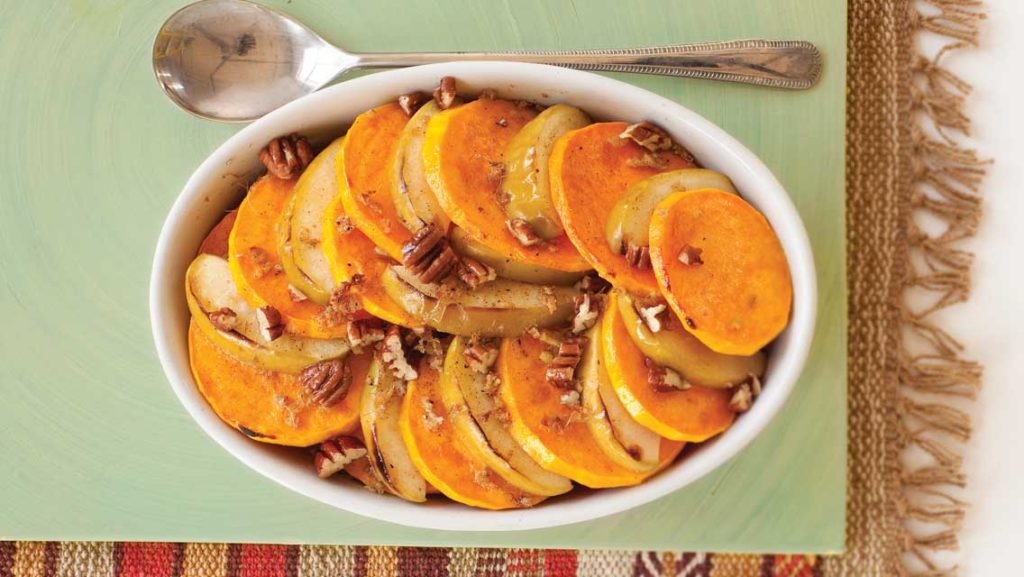
Makes | six servings
Ingredients
- 1/4 cup unsalted butter, plus butter to grease the baking dish
- 1 1/4 pounds squash, such as butternut, kabocha or acorn, peeled and seeded and sliced into ¼-inch wedges (about 4 cups)
- 2 medium baking apples, such as Granny Smith, cored and sliced into ¼-inch wedges
- 2 tbs. minced fresh gingerroot
- Salt and freshly ground black pepper to taste
- 1/2 tsp. cinnamon or pumpkin pie spice (optional)
- 1/3 cup chopped pecans
Directions
- Preheat the oven to 350 degrees F.
- Lightly butter a 2-quart baking dish and layer the squash and apple slices overlapping each other.
- Melt the 1/4 cup butter, add the ginger, and season with salt and freshly ground black pepper. If you would like to add a little cinnamon or pumpkin pie spice, add a 1/2 teaspoon to the butter mixture.
- Pour the butter mixture over the squash and apples.
- Cover the pan tightly with foil and bake for about 15 minutes, then uncover and continue to bake for another 25 minutes or until squash is tender.
- Top with pecans.
Spaghetti Squash “Carbonara”
A pasta-free version of the popular pasta Carbonara. Try topping it with a poached egg for added protein and unctuousness.
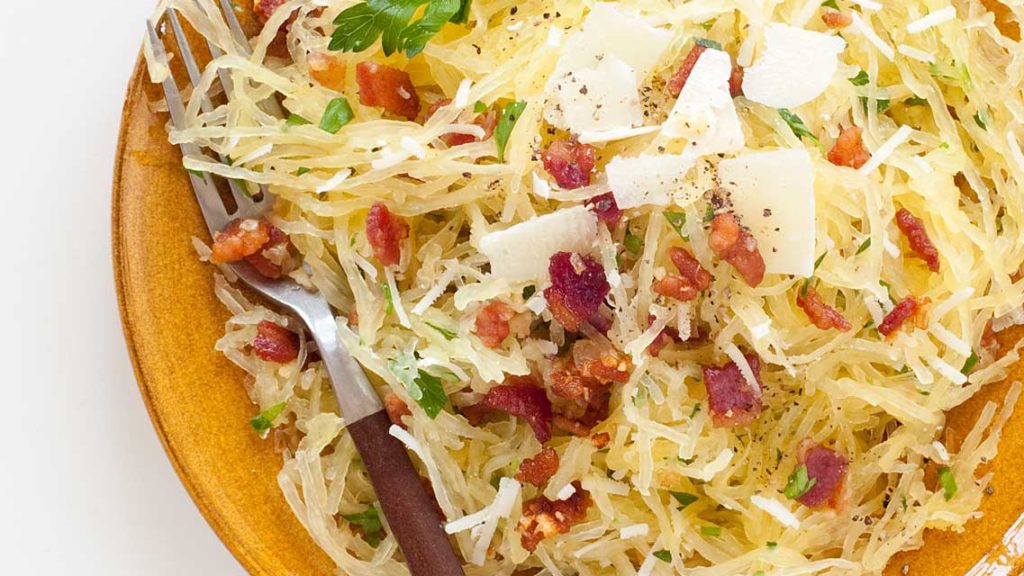
Makes | four to six servings
Ingredients
- 2 pounds spaghetti squash (about 1 medium spaghetti squash)
- 4 slices thick-sliced bacon, minced
- 2 tbs. minced shallot
- 2 to 3 cloves garlic, minced
- 1/2 cup chopped fresh Italian parsley
- 1/2 cup grated Parmesan cheese
- Salt and freshly ground black pepper to taste
Directions
- Cut spaghetti squash in half, scoop out the seeds, and place cut side down in a large pot of simmering 1-inch deep water. Cover and steam over low heat for seven to 10 minutes.
- Remove squash carefully from the pot and scoop out the cooked squash strands with a large spoon. Use a fork to separate the strands.
- Keep the squash warm in a bowl in the oven while you cook the bacon, shallots and garlic.
- Heat a heavy skillet and add the bacon, stirring to cook evenly. When the bacon is almost crisp, add the shallots and cook one to two minutes, then add the garlic.
- Toss the bacon mixture with the warm spaghetti squash and add the chopped parsley and half of the grated Parmesan, tossing together to mix evenly.
- Season with salt and freshly ground pepper to taste.
- Serve and top each portion with the remaining Parmesan cheese and more freshly ground black pepper.
Stuffed Acorn Squash
For a warm and hearty autumn meal, serve this savory main dish with braised greens.
Makes | four servings
Ingredients
- 2 acorn squash, cut in half lengthwise and seeded
- 1 tbs. olive oil or butter
- 8 ounces ground pork or turkey sausage
- 1/2 cup chopped onion
- 1 cup chopped celery
- 2 cups cooked wild rice
- 1/4 cup dried cranberries or cherries, chopped slightly
- 1/2 tsp. dried sage
- 1/2 tsp. dried rosemary
- Salt and freshly ground black pepper to taste
Directions
- Heat the oven to 350 degrees F.
- Lightly oil a baking pan and place the squash cut side down on the baking sheet and bake until squash is just tender, about 10 minutes.
- Prepare the stuffing while the squash is roasting.
- Heat oil or butter in a heavy skillet and cook the sausage, stirring to keep it in smaller crumbles. When sausage is cooked, add the onion and celery and cook until tender.
- Add the sausage mixture to cooked wild rice and mix with the cranberries and herbs; add salt and freshly ground black pepper to taste.
- Remove the squash from the oven, and with a spatula turn over so the cut side is up. Fill the opening with the stuffing, dividing evenly.
- Cover the stuffed squash with aluminum foil and return to the oven and bake for about 15 minutes, until the stuffing is heated through.
- Remove the foil and bake for another five minutes.
Winter Squash Made Easy: A Q&A With Sara Moulton
Sara Moulton grew up eating winter squash baked with brown sugar at Thanksgiving. Now she incorporates a variety of winter squashes into her home cooking and in recipes that help busy people get dinner on the table. Moulton is the host of the public television show Sara’s Weeknight Meals and author of three books, including Sara Moulton’s Everyday Family Dinners , and her iPhone app Sara’s Kitchen offers several recipes, photos and videos. Here’s what she has to say about the heartiest of cool-weather veggies, and why they remain enduring favorites in her pantry:
How are winter and summer squashes different?
Summer squash has thin skin and a much higher water content, is much more delicate, and is around in the summer. I find it more bland, frankly, although you can concentrate its flavor. It’s your quick-and-easy, no-time-at-all, cook-it-up-now squash.
Winter squash is in season from fall until spring. It’s larger and has harder skin that is usually inedible. I find, for the most part, it has a finer-grained texture and deeper flavor than summer squash.
What’s your advice to those who find winter squash intimidating?
I think what scares people is that it can be difficult to cut up because the skin is so hard and the shape is round. So for beginners I would recommend roasting it whole, and cutting it up after it’s cooled enough to safely handle. (For tips on how to cut a winter squash, see “Kitchen Tricks.”.
What are some key mistakes people make when cooking squash?
I wouldn’t recommend boiling it because it’s just going to be a wet mess. Also, you don’t want to overcook spaghetti squash when steaming or baking. Part of what you want with a spaghetti squash is for the strands to stay intact. Spaghetti squash has a very delicate flavor, so you’re looking for texture.
What is your favorite winter squash?
My all-time, hands-down favorite is the miniature pumpkins that people think are decorative. The flavor of these — almost uniformly — is so intensely wonderful.
Beyond roasting or steaming, what’s a good, simple preparation?
Peel and cut a butternut squash into chunks that fit through the feed tube of a food processor fitted with a grating disk. After you grate it, it takes only about three minutes in a large skillet to sauté, and then it’s done and ready to eat. Add anything — toasted pine nuts, sage and toasted walnuts are great. Nuts, in general, are very good with winter squash.
What flavors pair well with winter squashes?
Winter squash tends to be either starchy or sweet. If it’s starchy, anything you do with a potato, such as mash it or use it in a gratin, you can do with a winter squash. If it’s sweet, try anything you do with a carrot or a sweet potato, such as pair with brown sugar or maple syrup or honey. Sweeter winter squashes like pumpkins, butternut squash and delicata also do a nice dance with chilies.
All recipes were created by Betsy Nelson (a.k.a. “That Food Girl”), a Minneapolis-based food stylist and recipe developer.
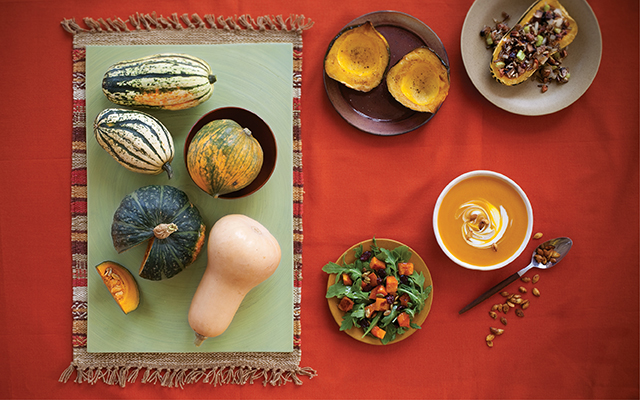
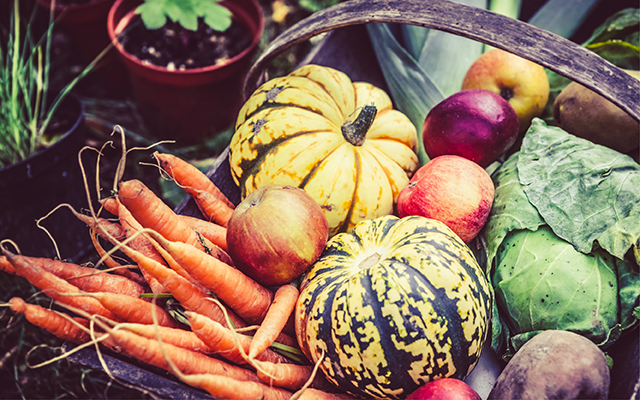
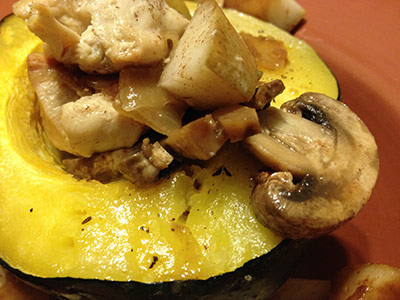
This Post Has 0 Comments